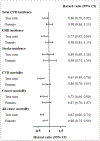Nut Consumption in Relation to Cardiovascular Disease Incidence and Mortality Among Patients With Diabetes Mellitus
- PMID: 30776978
- PMCID: PMC6417933
- DOI: 10.1161/CIRCRESAHA.118.314316
Nut Consumption in Relation to Cardiovascular Disease Incidence and Mortality Among Patients With Diabetes Mellitus
Abstract
Rationale: The evidence regarding the potential health benefits of nut consumption among individuals with type 2 diabetes mellitus is limited.
Objective: To examine intake of total and specific types of nuts, including tree nuts and peanuts, in relation to subsequent risk of cardiovascular disease (CVD), including coronary heart disease and stroke, and all-cause and cause-specific mortality among individuals with diabetes mellitus.
Methods and results: This prospective analysis included 16 217 men and women with diabetes mellitus at baseline or diagnosed during follow-up (Nurses' Health Study: 1980-2014, Health Professionals Follow-Up Study: 1986-2014). Nut consumption was assessed using a validated food frequency questionnaire and updated every 2 to 4 years. During 223 682 and 254 923 person-years of follow-up, there were 3336 incident CVD cases and 5682 deaths, respectively. Higher total nut consumption was associated with a lower risk of CVD incidence and mortality. The multivariate-adjusted hazard ratios (95% CIs) for participants who consumed 5 or more servings of total nuts per week (1 serving=28 g), compared with those who consumed <1 serving per month, were 0.83 (0.71-0.98; P trend=0.01) for total CVD incidence, 0.80 (0.67-0.96; P trend=0.005) for coronary heart disease incidence, 0.66 (0.52-0.84; P trend <0.001) for CVD mortality, and 0.69 (0.61-0.77; P trend <0.001) for all-cause mortality. Total nut consumption was not significantly associated with risk of stroke incidence or cancer mortality. For specific types of nuts, higher tree nut consumption was associated with lower risk of total CVD, coronary heart disease incidence, and mortality because of CVD, cancer, and all causes, whereas peanut consumption was associated with lower all-cause mortality only (all P trend <0.001). In addition, compared with participants who did not change the consumption of total nuts from pre- to post-diabetes mellitus diagnosis, participants who increased consumption of total nuts after diabetes mellitus diagnosis had an 11% lower risk of CVD, a 15% lower coronary heart disease risk, a 25% lower CVD mortality, and a 27% lower all-cause mortality. The associations persisted in subgroup analyses stratified by sex/cohort, body mass index at diabetes mellitus diagnosis, smoking status, diabetes mellitus duration, nut consumption before diabetes mellitus diagnosis, or diet quality.
Conclusions: Higher consumption of nuts, especially tree nuts, is associated with lower CVD incidence and mortality among participants with diabetes mellitus. These data provide novel evidence that supports the recommendation of incorporating nuts into healthy dietary patterns for the prevention of CVD complications and premature deaths among individuals with diabetes mellitus.
Keywords: cardiovascular disease; diabetes mellitus; diet; epidemiology; mortality; nuts.
Figures



Comment in
-
Nuts, Cardiovascular Health, and Diabetes.Circ Res. 2019 Mar 15;124(6):825-826. doi: 10.1161/CIRCRESAHA.119.314752. Circ Res. 2019. PMID: 30870120 Free PMC article. No abstract available.
Similar articles
-
Changes in Nut Consumption and Subsequent Cardiovascular Disease Risk Among US Men and Women: 3 Large Prospective Cohort Studies.J Am Heart Assoc. 2020 Apr 7;9(7):e013877. doi: 10.1161/JAHA.119.013877. Epub 2020 Apr 1. J Am Heart Assoc. 2020. PMID: 32233756 Free PMC article.
-
Association between nut consumption and mortality risk: a 20-year cohort study in Korea with a stratified analysis by health-related variables.Nutr J. 2024 Sep 28;23(1):113. doi: 10.1186/s12937-024-01019-y. Nutr J. 2024. PMID: 39342232 Free PMC article.
-
Nut Consumption and Risk of Cardiovascular Disease.J Am Coll Cardiol. 2017 Nov 14;70(20):2519-2532. doi: 10.1016/j.jacc.2017.09.035. J Am Coll Cardiol. 2017. PMID: 29145952 Free PMC article.
-
Nut consumption and incidence of cardiovascular diseases and cardiovascular disease mortality: a meta-analysis of prospective cohort studies.Nutr Rev. 2019 Oct 1;77(10):691-709. doi: 10.1093/nutrit/nuz042. Nutr Rev. 2019. PMID: 31361320 Free PMC article.
-
Nut consumption in relation to all-cause and cause-specific mortality: a meta-analysis 18 prospective studies.Food Funct. 2017 Nov 15;8(11):3893-3905. doi: 10.1039/c7fo00915a. Food Funct. 2017. PMID: 28875220 Review.
Cited by
-
High-accuracy classification and origin traceability of peanut kernels based on near-infrared (NIR) spectroscopy using Adaboost - Maximum uncertainty linear discriminant analysis.Curr Res Food Sci. 2024 May 8;8:100766. doi: 10.1016/j.crfs.2024.100766. eCollection 2024. Curr Res Food Sci. 2024. PMID: 38770517 Free PMC article.
-
Nut consumption and disability-free survival in community-dwelling older adults: a prospective cohort study.Age Ageing. 2024 Nov 1;53(11):afae239. doi: 10.1093/ageing/afae239. Age Ageing. 2024. PMID: 39551942 Free PMC article.
-
Destigmatizing Carbohydrate with Food Labeling: The Use of Non-Mandatory Labelling to Highlight Quality Carbohydrate Foods.Nutrients. 2020 Jun 9;12(6):1725. doi: 10.3390/nu12061725. Nutrients. 2020. PMID: 32526896 Free PMC article. Review.
-
The Association between Nuts Intake and Non-Alcoholic Fatty Liver Disease (NAFLD) Risk: a Case-Control Study.Clin Nutr Res. 2020 Jul 27;9(3):195-204. doi: 10.7762/cnr.2020.9.3.195. eCollection 2020 Jul. Clin Nutr Res. 2020. PMID: 32789149 Free PMC article.
-
Food and Nutrient Displacement by Walnut Supplementation in a Randomized Crossover Study.Nutrients. 2022 Feb 28;14(5):1017. doi: 10.3390/nu14051017. Nutrients. 2022. PMID: 35267992 Free PMC article. Clinical Trial.
References
-
- Kris-Etherton PM, Hu FB, Ros E, Sabate J. The role of tree nuts and peanuts in the prevention of coronary heart disease: Multiple potential mechanisms. J Nutr. 2008;138:1746S–1751S - PubMed
-
- Ros E, Tapsell LC, Sabate J. Nuts and berries for heart health. Curr Atheroscler Rep. 2010;12:397–406 - PubMed
-
- Aune D, Keum N, Giovannucci E, Fadnes LT, Boffetta P, Greenwood DC, Tonstad S, Vatten LJ, Riboli E, Norat T. Nut consumption and risk of cardiovascular disease, total cancer, all-cause and cause-specific mortality: A systematic review and dose-response meta-analysis of prospective studies. BMC Med. 2016;14:207. - PMC - PubMed
-
- van den Brandt PA, Schouten LJ. Relationship of tree nut, peanut and peanut butter intake with total and cause-specific mortality: A cohort study and meta-analysis. Int J Epidemiol. 2015;44:1038–1049 - PubMed
-
- Zhou D, Yu H, He F, Reilly KH, Zhang J, Li S, Zhang T, Wang B, Ding Y, Xi B. Nut consumption in relation to cardiovascular disease risk and type 2 diabetes: A systematic review and meta-analysis of prospective studies. Am J Clin Nutr. 2014;100:270–277 - PubMed

